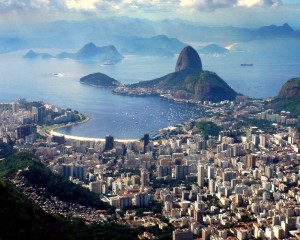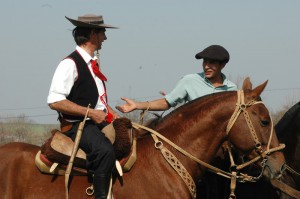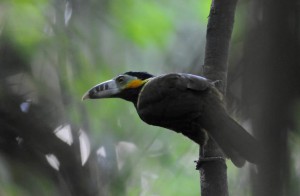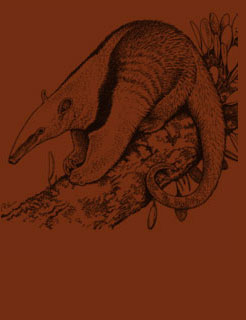 The giant of South America is the continent’s largest country and fifth in the world. Its 8.5 million square kilometers of land are covered by beaches, huge cities, waterfalls, 191, 5 million people, carnival, football and the jungle, much forest, the overwhelming green of the Amazon rainforest lining 3.6 million km ² in North Central region. But it is not unique. To the south, the Parana forest is home to the Iguassu Falls, natural wonder that it shares with Argentina and it is separated by the river of the same name.
The giant of South America is the continent’s largest country and fifth in the world. Its 8.5 million square kilometers of land are covered by beaches, huge cities, waterfalls, 191, 5 million people, carnival, football and the jungle, much forest, the overwhelming green of the Amazon rainforest lining 3.6 million km ² in North Central region. But it is not unique. To the south, the Parana forest is home to the Iguassu Falls, natural wonder that it shares with Argentina and it is separated by the river of the same name.
It is the only Latin American country where people speak Portuguese as official language and shares borders with almost all its neighbors, except Ecuador and Chile.
Unlike Argentina, the seasons are not well defined; being predominantly tropical climate, with little cold temperatures, with the exception of the southern region, where winter is felt, being below the Tropic of Capricorn.
Continue reading →
 Located at the south of the southern hemisphere, in South America, Argentina is a Country crossed by diversity. From north to south and from east to west, each region is unique and is distinguished by its characteristics. Its vast territory of almost 3.8 million km ² is immersed in latitude that gives the well-defined four seasons: summer from December to March, autumn from March to June, winter from June to September and spring September December. Its neighboring countries are on the north, Paraguay and Bolivia, Brazil’s northeast, west, Andes through Chile and the east, Uruguay, accompanied by 4,725 miles of coastline on the Atlantic Ocean.
Located at the south of the southern hemisphere, in South America, Argentina is a Country crossed by diversity. From north to south and from east to west, each region is unique and is distinguished by its characteristics. Its vast territory of almost 3.8 million km ² is immersed in latitude that gives the well-defined four seasons: summer from December to March, autumn from March to June, winter from June to September and spring September December. Its neighboring countries are on the north, Paraguay and Bolivia, Brazil’s northeast, west, Andes through Chile and the east, Uruguay, accompanied by 4,725 miles of coastline on the Atlantic Ocean.
The economic and political capital of the country is Buenos Aires. Lying on the Río de la Plata is the gateway for foreign visitors. Ezeiza International Airport, located 22 km. away from the Federal Capital, it receives all external flights and Aeroparque Jorge Newbery, just 2 miles from downtown, connects the city with the rest of the country.
Continue reading →
 The location of Yacutinga Wildlife Reserve belongs to the phytogeographical area of the Parana Forest.
The location of Yacutinga Wildlife Reserve belongs to the phytogeographical area of the Parana Forest.
This is one of the most bio-diverse areas in Argentina.
The main characteristics that generate this exuberant Nature are its warm climate, constant humidity, and the lack of dry seasons and of changing climate.
These environmental conditions make the area a sort of giant greenhouse. This is a completely green, stubborn and many a times, impenetrable forest. The forest structure becomes apparent in its different plant strata, which provide more than 320 bird species listed in Yacutinga with shelter, food and reproduction sites.
Continue reading →
 The giant of South America is the continent’s largest country and fifth in the world. Its 8.5 million square kilometers of land are covered by beaches, huge cities, waterfalls, 191, 5 million people, carnival, football and the jungle, much forest, the overwhelming green of the Amazon rainforest lining 3.6 million km ² in North Central region. But it is not unique. To the south, the Parana forest is home to the Iguassu Falls, natural wonder that it shares with Argentina and it is separated by the river of the same name.
The giant of South America is the continent’s largest country and fifth in the world. Its 8.5 million square kilometers of land are covered by beaches, huge cities, waterfalls, 191, 5 million people, carnival, football and the jungle, much forest, the overwhelming green of the Amazon rainforest lining 3.6 million km ² in North Central region. But it is not unique. To the south, the Parana forest is home to the Iguassu Falls, natural wonder that it shares with Argentina and it is separated by the river of the same name.

 Located at the south of the southern hemisphere, in South America, Argentina is a Country crossed by diversity. From north to south and from east to west, each region is unique and is distinguished by its characteristics. Its vast territory of almost 3.8 million km ² is immersed in latitude that gives the well-defined four seasons: summer from December to March, autumn from March to June, winter from June to September and spring September December. Its neighboring countries are on the north, Paraguay and Bolivia, Brazil’s northeast, west, Andes through Chile and the east, Uruguay, accompanied by 4,725 miles of coastline on the Atlantic Ocean.
Located at the south of the southern hemisphere, in South America, Argentina is a Country crossed by diversity. From north to south and from east to west, each region is unique and is distinguished by its characteristics. Its vast territory of almost 3.8 million km ² is immersed in latitude that gives the well-defined four seasons: summer from December to March, autumn from March to June, winter from June to September and spring September December. Its neighboring countries are on the north, Paraguay and Bolivia, Brazil’s northeast, west, Andes through Chile and the east, Uruguay, accompanied by 4,725 miles of coastline on the Atlantic Ocean. The location of Yacutinga Wildlife Reserve belongs to the phytogeographical area of the Parana Forest.
The location of Yacutinga Wildlife Reserve belongs to the phytogeographical area of the Parana Forest.